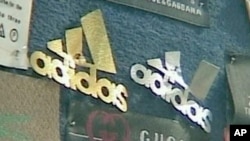Despite the Iranian government's aversion to nearly all things Western, the country's predominantly young consumers can't seem to get enough of Western brand names. In most of the country's shopping bazaars, popular brand names from Adidas to Gucci can be found in great abundance. But the majority of designer products sold in Iran are fake.
Designer labels on display in a store in Tehran.
It looks like any modern shopping district, with popular brands such as Gucci, Benetton and La Senza all vying for the attention of fashion conscious consumers. But this is downtown Tehran.
After being closed for years to Western businesses, Iranian consumers are flocking to buy imported designer brands.
But one shopkeeper who did not want to be identified says most are not willing to pay designer prices. "The customers want to buy Western brands. But if you say it is an Ahmadi [local] brand, they would never buy it. We have to use the fake brands or trademarks for our products that the customers like," he said.
With more than 70 percent of Iran's 73 million people under the age of 35, there is a huge demographic demand for high fashion. But with most families earning an average of only about $600 a month, most shoppers say they cannot afford to buy the real thing.
"Few people can afford to buy authentic Adidas. Few people can afford to pay 100,000 toman [$100] to buy an Adidas T-shirt. They have to buy a fake one for 10,000 toman [$10]. It is better anyway. You know affordability is important," one shopper said.
Iranian authorities have turned a blind eye to the wholesale trade in fakes. And with no official sanctions against the illegal activity, local manufacturers don't even try to hide the fake labels and logos that can turn locally made goods into hip, fashion statements.
Ali Tamineh is a salesman at an upscale designer store. He says that attitude is making it harder for legitimate brands to survive in Iran.
"We are the representative of a famous brand with 77 branches across the country. Our brand is authentic, but we face great difficulties here. There are people out there who make some changes to the original design then produce and distribute it with a fake trademark, and miserable quality," the salesman said.
Tamineh says in the end, shoppers who pay for cheap knock offs are the ones who lose out.
Vahid is typical of young Tehran consumers.
"We young people in Iran, we really care about brands and would like to buy outfits with famous brands. Unfortunately, most shopping centers offer fake brands. There is scarcity of originals. In the past three or four years famous brands such as Diesel, Benetton, Puma and Adidas have launched branches. We can only trust those and do our shopping there. There are no other brands. I dare to say that 90 percent of the outfit and clothing market in Iran is fake and most people know it," one shopper said.
The economic impact of the sale of fake goods in Iran is hard to quantify. But worldwide, estimates peg losses due to the sale of counterfeit goods in the hundreds of billions of dollars, affecting products from fashion clothing to computer software.










